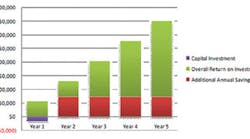Harrison Steel Castings Co. in Attica, IN, is more than a century old, but forward-looking. Taking advantage of U.S. Environmental Protection Agency and U.S. Dept. of Energy partnerships, the supplier of engineered components to agriculture, heavy equipment, energy, military, mining, and oil-and-gas customers has saved a significant volume of the energy needed to drive its multi-faceted organization.
EPA’s Energy Star for Industry Program works with industrial companies to institute energy-management plans, and to establish corporate energy-management programs and practices. Harrison Steel has been an Energy Star “partner” for several years, and received an energy audit of its operations in 2006.
Like almost any foundry, Harrison Steel necessarily consumes high volumes of energy, so efforts to reduce operating costs by reducing energy usage can have a positive effect on its revenues and give it a competitive advantage with casting buyers. The audit identified various ways to achieve better energy efficiency.
According to the DOE, energy costs typically represent 5-8% of Harrison Steel’s total sales, so it recognized that energy efficiency projects might increase its profits without necessarily increasing sales volume. As a comparative example, DOE describes a company with similar profit margins that cuts energy spending by $66,000 through efficiency measures but would have to increase its total sales by $1 million in order to achieve the same financial impact.
Since the initial 2006 energy audit, Harrison Steel has undertaken several projects identified as potential cost and energy savers. One of these projects involved updating the natural-gas burners that preheat ladles for molten steel. While the implementation costs were reasonable ($17,500, according to DOE) Harrison Steel was able to reduce operating expenses significantly as a result.
The burners that Harrison Steel employed prior to the upgrade were based on out-dated technology, used a suboptimal air/gas mixture, and produced a poor flame shape. Just by improving the burners, DOE estimated energy savings at $73,857/year, which meant ROI was achieved in less than three months. To achieve the same annual affect by increasing sales, Harrison Steel would have had to generate an additional $1,119,045 (See Fig. 1 for the project’s five-year ROI estimate.)
A second project that Harrison Steel is pursuing involves variable-speed drives for its well pump. This upgrade will slow the pump to control the plant water pressure rather than using pressure-demand valves to throttle the pump while it is running at full speed. Installing the new drive will cost $25,000, according to DOE, but it will save the operation approximately $16,800 per year in electricity costs. (See Fig. 2 for this project’s five-year ROI estimate).
In addition to these projects, Harrison Steel has eliminated over 100 air leaks in its various systems, which has produced an estimated $105,600/year in annual energy savings, with payback in less than 18 months. These were the simple projects that encouraged Harrison Steel to appoint an in-house energy-management team and start working with other organizations to continue achieving energy savings.
EPA’s Energy Star for Industry Program is a voluntary government partnership that made sense for Harrison Steel because of the guidance it offers for developing and strengthening energy-management plans, and establishing corporate energy-management programs and practices. The foundry started its Energy Star partnership in the fall of 2009, seeing it as a way to build a sustainable energy-management framework and to make its efforts more tangible to workers (versus an engineering task list.)
So far, there have been two major benefits from the partnership. First, the Harrison Steel has gained the insights of DOE’s strategic energy advisor, to form an effective Energy Team.
Second, Harrison Steel has collected practical ideas from Energy Star Web Conferences, which have introduced it to other manufacturers with similar energy-management goals and challenges. Thanks to its Energy Team, Harrison Steel was able to complete a lighting project that had been under consideration since the 2006 energy audit, but that finally was approved for with the assistance of Energy Star.
Since joining the Energy Star partnership, Harrison Steel also joined the DOE Industrial Technology Program’s Save Energy Now Leader Program — a 10-year initiative to drive a reduction in industrial energy intensity by 25%.
Save Energy Now helps manufacturers reduce their energy intensity. It supplies technical assistance, tools, and training to help industrial operations implement energy-management strategies, as well as efficiency improvements for industrial processes.
The program provides technical expertise for engineering efforts to control energy consumption, and since joining it earlier this year Harrison Steel has found it to be complementary to its work with the EPA program: Energy Star helped it to improve its energy-management program; Save Energy Now supplied technical assistance to implement efficiency improvements to its industrial systems and processes.
The Save Energy Now online materials were notably effective. Harrison Steel took advantage of the materials there, such as information on improving energy efficiency through upgrading existing standard belts to newer v-belts for belt-driven equipment (e.g., fans.) Other online materials offered insights about implementing a combustion-efficiency program being considered for heat-treating furnaces.









